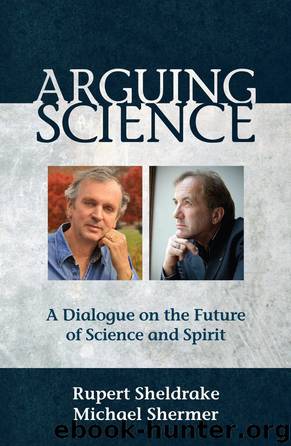Arguing Science by Sheldrake Rupert; Shermer Michael;

Author:Sheldrake, Rupert; Shermer, Michael; [Shermer, Rupert Sheldrake and Michael]
Language: eng
Format: epub
Publisher: Monkfish Book Publishing
Published: 2016-09-27T16:00:00+00:00
As well, skeptics are not “crusaders … fighting against infidels and heretics.” We’re critical thinkers applying science and reason to any and all claims. You, for example, are a skeptic of the materialist-determinist-reductionist paradigm in science, but that doesn’t make mainstream scientists infidels and heretics! Organized skeptical movements that have spontaneously emerged around the world are interested in understanding and explaining phenomena on the borderlands of science (e.g., ESP), primarily because most scientists are too busy working in their own fields to devote the necessary time to properly analyze these claims. We’re not closed-minded so much as conservative (cognitively, not politically) in offering our provisional assent that a claim is factually true. The reason for this cautiousness is that most claims people make are not true. The history of science is littered with failed hypothesis. For every Galileo whose ideas were borne out by the data and whose theories changed the world, there are thousands of scholars and scientists whose conjectures and speculations failed to generate any supportive evidence.
Like most scientists, we skeptics assume the null hypothesis that a claim under investigation is not true (null) until proven otherwise, and the burden of proof is on you to provide convincing experimental data to reject the null hypothesis. And this brings me to the topic of our second set of exchanges about mental action at a distance. Take ESP and a simple example I employed in my book The Believing Brain: From Ghosts to Gods to Politics and Conspiracies—How We Construct Beliefs and Reinforce Them as Truths (Times Books, 2011): determining through extra-sensory means whether a playing card randomly selected from a deck is red or black. The null hypothesis is that it is not possible to do this and thus to reject the null hypothesis we would need to establish a figure for the number of correct hits. By chance, we would expect a test subject to get about half correct. In a deck of 52 cards, half of which are red and half of which are black, random guessing or flipping a coin will produce, on average, 26 correct hits. Of course, as gamblers know, there are streaks and deviations from perfect symmetry. The roll of a roulette wheel will not produce a perfect red-black-red-black sequence. Typically, streaks of red and black turn up, often more of one than the other in any given limited sequence, without any violation of the laws of probability.
So for a proper test, we need to run multiple trials in which some rounds may result in slightly below chance (e.g., 22, 23, 24, or 25 hits) and other rounds may result in slightly above chance (e.g., 27, 28, 29, or 30 hits). The variation may be even greater and still due to chance. What we need to determine is the number by which we can confidently reject the null hypothesis. In this example, that number is 35. The subject would need to get 35 correct hits out of a 52-card deck in order for us to reject the null hypothesis at the 99 percent confidence level.
Download
This site does not store any files on its server. We only index and link to content provided by other sites. Please contact the content providers to delete copyright contents if any and email us, we'll remove relevant links or contents immediately.
| ESP | Near-Death Experiences |
| Out-of-Body Experiences |
Animal Frequency by Melissa Alvarez(4148)
Sigil Witchery by Laura Tempest Zakroff(4027)
Real Magic by Dean Radin PhD(3922)
Fingerprints of the Gods by Graham Hancock(3733)
Journeys Out of the Body by Robert Monroe(3460)
Aleister Crowley: The Biography by Tobias Churton(3424)
The Rosicrucians by Christopher McIntosh(3371)
Alchemy and Alchemists by C. J. S. Thompson(3294)
Mysteries by Colin Wilson(3248)
Hitler's Monsters by Eric Kurlander(3162)
The Hatha Yoga Pradipika (Translated) by Svatmarama(3071)
John Dee and the Empire of Angels by Jason Louv(3046)
Wicca: a guide for the solitary practitioner by Scott Cunningham(3040)
Infinite Energy Technologies by Finley Eversole(2831)
Dark Star Rising by Gary Lachman(2738)
The Book of Lies by Aleister Crowley(2719)
Book of Life by Deborah Harkness(2717)
Aliens by Jim Al-Khalili(2703)
To Light a Sacred Flame by Silver RavenWolf(2671)
